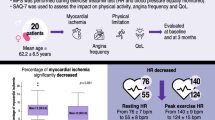Summary
The duration of action of tiapamil was assessed in ten patients with stable exertional angina. Maximal symptom-limited treadmill exercise electrocardiography was performed before and at 1, 3, 6 and 9 h after therapy. Significant differences were only found at 1 h after tiapamil with increases in mean exercise duration (312 vs 399 s), the time to onset of angina (221 vs 310 s) and exercise work load (5.9 vs 7.3 METS). Tiapamil had no significant effect on the exercise heart rate but increased the resting heart rate by 6 beats/minute. The resting systolic blood pressure fell by 17 mmHg (p<0.01), and the diastolic blood pressure by 14 mmHg. Exercise systolic and diastolic blood pressures fell by 19 and 17 mmHg respectively. Side-effects were short-lived and attributable to vasodilatation. Tiapamil is effective for the relief of angina with minimal side-effects, but its duration of action is short. For effective chronic oral use, a sustained release preparation is required.
Similar content being viewed by others
References
Muller JE, Gunther SJ (1978) Nifedipine therapy for Prinzmental's angina. Circulation 67: 137–139
Yasue H, Omote S, Takizawa A, Nagao M, Miwa K, Tanaka S (1979) Exertional angina pectoris caused by coronary artery spasm. Effects of various drugs. Am J Cardiol 43: 647–651
Ellrodt G, Chew CYC, Singh BN (1980) Therapeutic implications of slow channel blockade in cardiocirculatory disorders. Circulation 62: 669–679
Eigenmann R, Gerold M, Haeusler G (1978) Cardiovascular effects of calcium antagonists in chronically instrumented, concious dogs. Experientia 34: 923
Ramuz H (1978) A new Ca++ antagonist Ro 11-1781 and its metabolites. Arzneimittelforsch 28: 2048–2051
Thorens S, Haeusler G (1978) Effects of some vasodilators on Ca-fluxes in vascular smooth muscle. Experientia 34: 980
Cocco G, Strozzi C, Chu D (1979) Human electropharmacology of the calcium antagonist dimeditiapramide (Ro 11-1781) in coronary patients. Clin Cardiol 2: 212–216
Gmeiner R, Ng CK, Gstottner M (1980) Effect of dimeditiapramide (Ro 11-1781) on reentrant tachycardia in WPW syndrome. Eur J Clin Invest 10: 13
Gmeiner R, Ng CK (1982) Electrophysiology of tiapamil in concealed accessory pathways. Cardiology 69 [Suppl 1]: 130–139
Gmeiner R, Ng CK, Gstottner M (1979) Effect on paroxysmal reentrant supraventricular tachycardia of a drug affecting calcium transport (Ro 11-1781). Eur J Pharmacol 16: 155–164
Gasic S (1982) Acute antianginal effect of tiapamil. Cardiol 69 [I]: 209–214
Salorinne Y, Himberg JJ, Eskelinen E (1983) Long-term treatment of patient with angina pectoris. Clin Cardiol 6: 171–175
Maltz MB, O'Keeffe JC, Butrous GS, Camm AJ (1985) Effects of tiapamil on exercise performance in patients with coronary artery disease. Eur Heart J 6 [Suppl 1]: 111
Bruce RA, Hornsten TR (1969) Exercise stress testing in evaluation of patients with ischemic heart disease, adult normal subjects and cardiac patients. Prog Cardiovas Dis 11: 371–391
American Heart Association report of the Ad Hoc Committee for the grading coronary artery disease. Council on Cardiovascular Surgery (1975) A reporting system on patients evaluated for coronary artery disease. Circulation 51: 540–544
Heizmann P, Wendt G, Von Alten, Zinapold K (1984) Determination of tiapamil and of its two main metabolites in plasma and in urine by high-performance liquid chromatography. J Chromatogr 310: 119–127
Gerold M, Eigenmann R, Haeusler G (1982) Cardiovascular effects of Tiapamil (Ro 11-1781), a new calcium-entry blocker. J Cardiovasc Pharmacol 4: 419–429
Singh BN (1982) An Overview of slow channel blocking drugs: Pharmacological basis for therapeutic applications. Proceedings of the First International Symposium on Tiapamil. Cardiology 69 [Suppl 1]: 2–25
Lindvall K, Cocco G, Wendt G, Chu D, Heizmann P (1981) Serial M-mode echocardiography in evaluation of the cardiovascular effects of tiapamil and their relationship to plasma level in patients with coronary heart disease. Int J Cardiol 1: 15–24
Wendt G (1982) Pharmacokinetics and metabolism of tiapamil. Cardiology 69 [Suppl 1]: 68–78
Balasubramanian V, Paramasivan R, Lahiri A, Raftery EB (1980) Verapamil in chronic stable angina: A controlled study with computerized multistage treadmill exercise. Lancet 1: 841
Author information
Authors and Affiliations
Rights and permissions
About this article
Cite this article
Maltz, M.B., Davies, D.W., Caplin, J.L. et al. Duration of action of tiapamil in stable exercise induced angina. Eur J Clin Pharmacol 32, 339–342 (1987). https://doi.org/10.1007/BF00543965
Received:
Accepted:
Issue Date:
DOI: https://doi.org/10.1007/BF00543965




